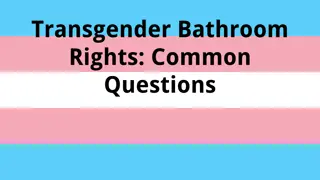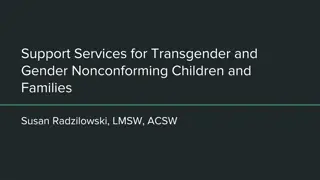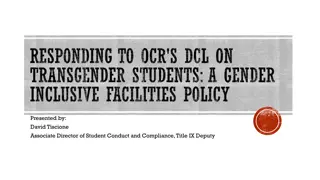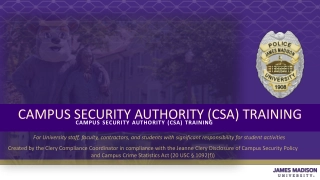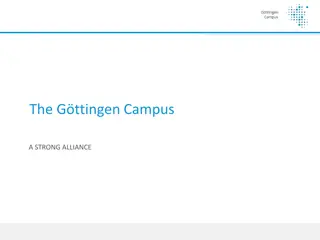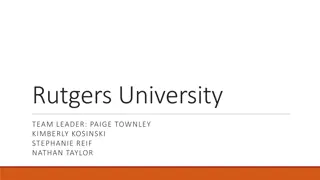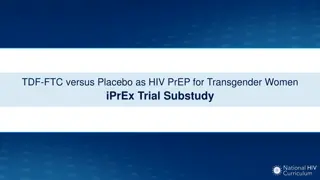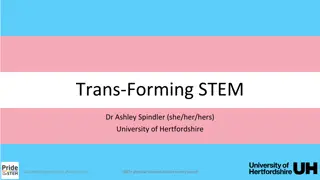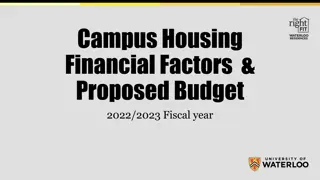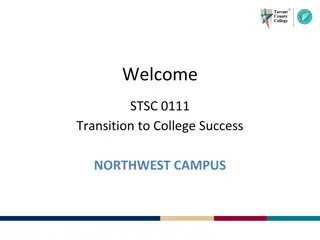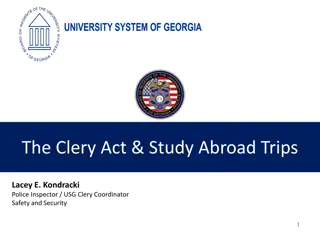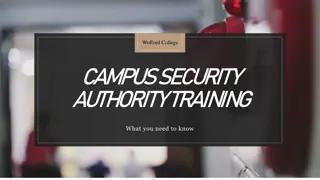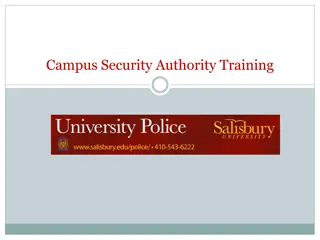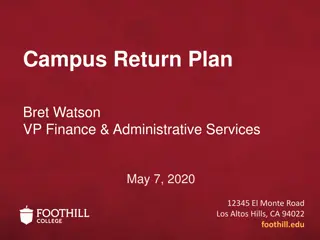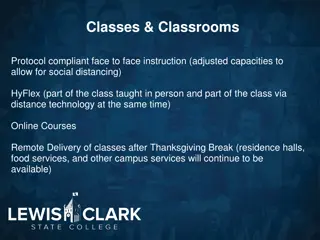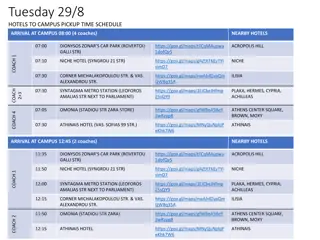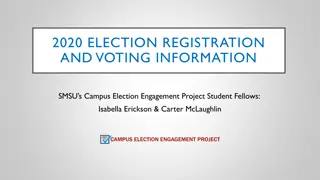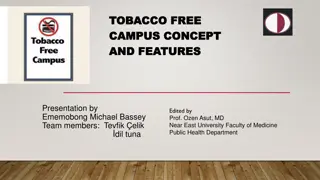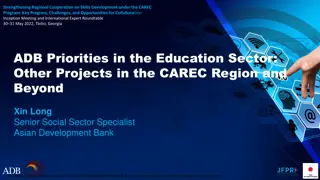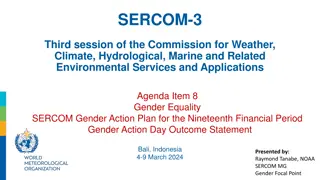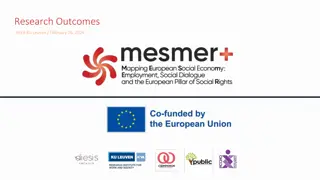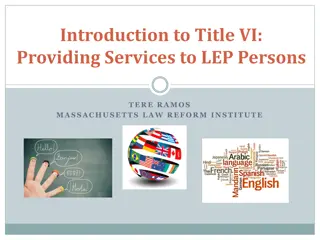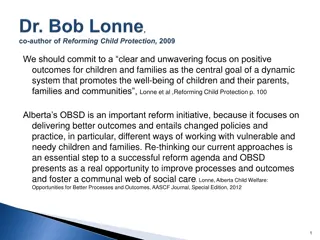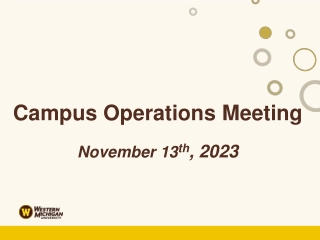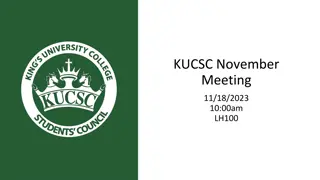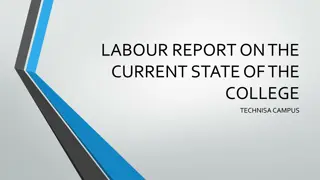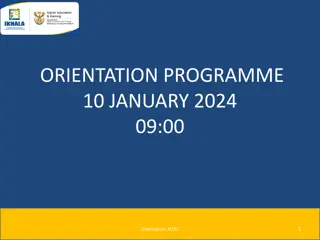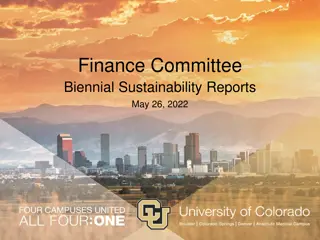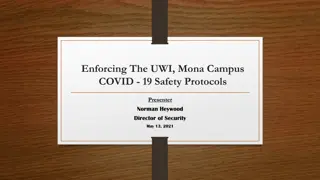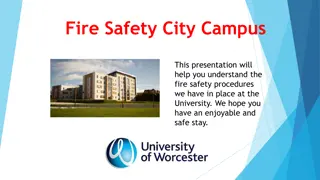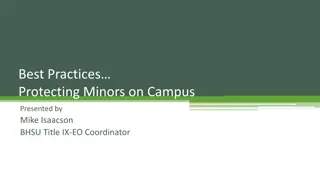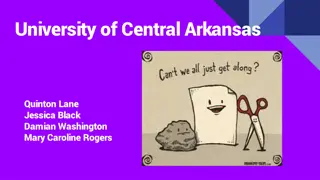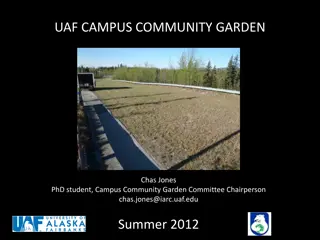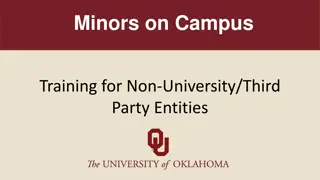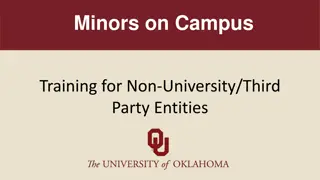Promoting Transgender Inclusiveness on Campus
Western Illinois University's team led by Caleb Maddox aims to educate, raise awareness, and drive change towards transgender inclusivity on their campus. The team presents findings on challenges faced by transgender students, process insights, and proposed short- and long-term solutions for fostering inclusivity and supporting the community.
Download Presentation

Please find below an Image/Link to download the presentation.
The content on the website is provided AS IS for your information and personal use only. It may not be sold, licensed, or shared on other websites without obtaining consent from the author. Download presentation by click this link. If you encounter any issues during the download, it is possible that the publisher has removed the file from their server.
E N D
Presentation Transcript
Transgender Inclusiveness How can we become educated, aware, and active in implementing change on our campus? Presented by Caleb Maddox (team leader), Caitlyn Westfall, Maggie Miller, and Danielle Flack - Western Illinois University
Overview Our President, Dr. Philias Fogg, has become very aware of the many tensions and inequities happening at colleges around the nation. While our campus has been tranquil up to this point, President Fogg wants to be proactive and begin working to improve specific areas within our institution in order to become more inclusive. When he communicated this to the Director of Student Services, the Director created a team of staff members from within the Division of Student Services to work on creating and implementing various ways for our campus to become more inclusive. After meeting with the director, we mutually agreed that we would begin by creating and conducting this presentation to the upper administration that would help to inform (you) on issues facing our transgender students and on potential steps that we believe could be taken to become an even more inclusive campus overall. We will be discussing what we currently know about creating inclusive environments for transgender students, what our process was in order to prepare, and then some short-and long-term solutions that we believe will help us achieve our goals.
Assumptions We Are Making This is a private university. There are religious undertones at this school that may be both for/against support for the transgender community. There may also be some political concerns tied to whether or not the students support the expansion/push for the transgender community inclusiveness. President Fogg thinks that the upper administration may not be up to date on current campus climates nationwide There is currently no transgender education for the administration. We are assuming the administration will be willing to go through this training. We do not currently have gender identity or expression listed in our nondiscrimination policy.
What do we know about Transgender inclusion? We know from the recent research and literature that most colleges and universities were not designed to be inclusive for Transgender students. However, many institutions are working on updating policies and procedures to make them more inclusive. This literature also informs us that there should be a focus on the authenticity of what the students are going through and what that authenticity can do to create policy change. We have seen institutions turn to this literature and these theories to implement best practices. These theories that have been created can be seen as a springboard to inform student affairs professionals at several different institutions and also have the power to pave a pathway for change. We found articles, presentations, website resources, and quotes to help provide concrete support for the increasing need of transgender student inclusion. Most of the information that we gathered has helped us better understand the importance of transgender inclusion. Below you will see a collection of these materials.
Relevant Theories/Literature about Transgender inclusion An interview with Judith Butler (2014) reminds us of the importance of ALL students: I believe that transgender people, including those who have transitioned, are living out real, authentic lives. Those lives should be celebrated, not questioned. An Exploratory Study of Identity Conceptualization and Development in a Sample of Gender Nonconforming Biological Females: A thesis shows the importance of inclusion and the challenges Trans* students face Regarding Tinto s retention model: The model theorizes that students who socially integrate into the campus community increase their commitment to the institution and are more likely to graduate (Tinto, 1975) Ten Strategies to Improve Trans Inclusiveness on Campus published in An Official Queer Guide to Higher Education (Alyson, 2006) gives us multiple strategies that are easily implementable to increase inclusiveness on college campuses Transgender Identity Development (Pardo, S. T., 2008): Recent developmental explorations of transgender identities suggest that trans people typically go through a process of dissonance, exploration, and disclosures that, when successful, leads to identity resolution
How we approached this topic: We looked at the decision issues: How can the college be a more welcoming environment for transgender students? University of Vermont provides compelling evidence that we as a society need to be more welcoming and inclusive of Trans* students (www.uvm.edu/~vtconn/v31/Schneider.pdf) What is the school doing well? The institution (or at least the President) is being progressive with their knowledge of current issues affecting campuses across the nation What can be done better? Help our campus become more aware of the issues facing transgender students and create a plan that will help us become inclusive and welcoming in ways we were previously unaware We questioned: How will we ensure that we are continuing education to the community about transgender student needs? How will we ensure that we meet the most realistic goals for helping our students?
How we approached this topic (continued): What are the facts necessary to dealing with the issues? President Fogg is concerned about the nationwide university issues (including transgender inclusion policies) and wants to ensure that they do not happen here at this mid-sized Centrist college he has led for eight years This campus has been tranquil in the midst of the issues everywhere else, but President Fogg feels his senior staff should be aware of the relevant issues as much as, if not more, than anyone else. The Director of Student Services assembled us into a team from within his department to create a professional development series for the senior staff. It is up to us (the group) to decide what should be emphasized. Because this is a moderate institution, the community s views on transgender identities will most likely vary. Because of this, we need to be focusing on the importance of transgender inclusion.
How we approached this topic (continued): What additional information must be collected? What is currently in place for transgender students here? What are other colleges doing to include this community of students? What is the current education around the topics of transgender identity, racial identity, and religious identity for both administration and students? How will our student population react to more inclusive language and policies? What are the attitudes of the administration toward this issue and will they support our initiatives? Who are the principal decision makers and what role do they play? Our Team Our role in this is to create and conduct research about how transgender inclusiveness issues are currently being seen on different campuses. This information can help us understand ways we can be more inclusive on campus overall. The Director of Student Services Initiated a plan to put a team together to brainstorm and implement ideas know to be more inclusive on campus.
Alternatives to the Solutions We Chose What else could we have focused on during training? Advocate for the campus health center to provide direct insurance coverage for hormones and gender confirmation surgeries for transitioning students. (Providing a separate insurance option for students to select rather than adding potential fees to regular student insurance) Advantages: More students would be covered for their needs; There would be more knowledgeable physicians available; These treatments and surgeries could be done in a more private setting; Some students would feel more welcomed on the campus Disadvantages: Having to find knowledgeable physicians willing to work on a college campus; This would be an additional cost for transgender students Widely publicize campus trans-inclusive policies. Advantages: Potentially recruit more students through positive media; Help our students and staff understand expectations we have of them. Disadvantages: Potentially lose potential students interested in the university
Alternatives to the solutions we chose (continued) Work with residence life to create transgender-inclusive housing options, including gender-inclusive rooms or floors. Cornell University provides a great example for how we could model this: https://living.sas.cornell.edu/live/apply/apply_undergrad/gender_inclusive_housing.cfm Advantages: Transgender students will feel more comfortable/included; This could expand student education through exposure; This could lessen the stigma of having opposite sexes live together. Disadvantage: This could potentially be more exclusive, rather than inclusive if in suite-style housing, because the students may not interact with other students as often Work with Student Activities, Fraternity/Sorority Life, Athletics, and other campus departments to develop policies that ensure that transgender students can be part of gender-specific student groups, fraternities and sororities, and sports teams. Advantages: Students will feel more welcomed and have a sense of belonging which should increase retention Disadvantages: Working with national fraternity/sorority headquarters/national sports corporations could be difficult and take a long time to see results; Potential scholarships through athletics could be exclusive; Students in the programs may feel uncomfortable with transgender peers in the organizations
Alternatives to the Solutions We Chose (continued) Work with the Registrar s Office to establish a simple, one-stop procedure for students to change the name and/or gender on all of their campus records and documents. Swarthmore College provides a short presentation on how to better handle name changes at institutions of higher education regarding Trans* students: handouts.aacrao.org/am07/finished/T1100a_M_Warner.pdf Advantages: Demonstrates our willingness to accept and work with every student and be flexible in order to meet their needs; This would make things more easily accessible and the students will not have to jump through a lot of hoops; This could make the process more comfortable for students to only have to disclose this information to one office Disadvantages: None noted at this time Sponsor regular transgender-specific programs and include transgender-related events during LGBT pride weeks and awareness months. Advantages: Students may feel more included and comfortable; There will be more transgender awareness on campus; This could potentially open the door to other population-specific programming Disadvantages: Possible backlash from some students who do not approve
The best options for us to begin implementing: The following solutions are what our team feels we should begin to implement at this time, based on short-term and long-term feasibility. This is not an exhaustive list, but rather a starting point. We believe that almost all of the alternative solutions listed previously could eventually be implemented to create a fully-inclusive college experience for our transgender students. Below, under each of our suggested solutions, we have included whether these are short-term or long-term goals and what the advantages and disadvantages are for each of them. Add gender identity or expression to the college s nondiscrimination policy. The National Association of College and University Attorneys provides relevant and meaningful case law to support the importance of this: http://www.nacua.org/nacualert/memberversion/Gender.asp This would be a short term goal, but with long term effects. We should begin the process of implementing this as soon as possible, as it may take some time to process. Advantages:It would create more inclusiveness; It would make some students or potential employees of the university feel more comfortable coming to the institution; We could set a national precedent, giving us more publicity and causing more students to want to attend; This will have an extremely low- cost; This will most likely garner positive media attention, opening our doors to an even larger population. Disadvantages:This could upset some of the student/employee population; It could create more division.
The best options for us to begin implementing (continued): Advocate for Student Affairs offices to change the gender category on their standardized forms to enable transgender students to self-identify, if they wish. This would also be a short-term goal that we could quickly implement, but would result in long-term effects Advantages: An overall feeling and sense of inclusion; This will be a low-cost solution Disadvantages: It will take time and likely require a number of drafts that will need approval. Include extensive transgender information and resources as part of an Ally or Safe Space program. This would be a long-term goal with long-term effects, but we can begin the process right away Advantages: Transgender awareness for our community; Specific training on how to deal with tough situations involving transgender individuals Disadvantages: While some people consider themselves to be allies to people who identify with a different sexual orientation, they do not always support the transgender identity; Money will be needed to create the resources
The best options for us to begin implementing (continued): Convert existing single-occupancy men s and women s restrooms into gender-neutral bathrooms and include gender-neutral bathrooms in new and renovated buildings. According to http://www.uua.org/lgbtq/welcoming/ways/bathrooms, this is one of the easiest changes to make for an inclusive campus. Short-term goal with long-lasting effects Advantages: This provides a space where the students should never feel like they have to conform to any one gender; there may potentially be a small cost Disadvantages: The students are still separated from others and not included in the main restrooms As previously noted, these are only the first steps we believe should be taken. We have chosen four goals to achieve what we believe should be our starting point during this process. We chose a mixture of short-term and long-term goals based on how feasible we believe they are, but they will also all have long lasting effects. Once we begin this process, we will revisit some of the other alternatives, as well as focus on some other very important steps to be taken to ensure inclusiveness for other identities in the near future.
References Beemyn, B. G. (2006). Ten strategies to include trans inclusiveness on campus. Best of the Best: An Official Queer Guide to Higher Education. Gender identity and expression issues at colleges and universities. (n.d.). Retrieved February 26, 2016, from http://www.nacua.org/nacualert/memberversion/Gender.asp Gender-Inclusive Housing. (n.d.). Retrieved February 26, 2016, from https://living.sas.cornell.edu/live/apply/apply_undergrad/gender_inclusive_housing.cfm Gender Performance: The TransAdvocate interviews Judith Butler. (2014). Retrieved February 26, 2016, from http://www.transadvocate.com/gender-performance-the-transadvocate-interviews-judith-butler_n_13652.htm Growing Up Transgender: Research and Theory. (2008, March). Retrieved February 26, 2016, from www.actforyouth.net/resources/rf/rf_trans-identity_0308.pdf
References (cont.) Schneider, W. (2010). Where do we belong? Addressing the needs of transgender students in higher education. Retrieved from www.uvm.edu/~vtconn/v31/Schneider.pdf Supporting transgender student name change. (n.d.). Retrieved from handouts.aacrao.org/am07/finished/T1100a_M_Warner.pdf Tinto,V. (1975) "Dropout from Higher Education: A Theoretical Synthesis of Recent Research" Review of Educational Research vol.45, pp.89-125 Transgender 101: Identity, Inclusion, and Resources. (2014). Retrieved February 22, 2016, from http://www.uua.org/lgbtq/identity/transgender
Thank You For Joining Us Today! Any questions?


